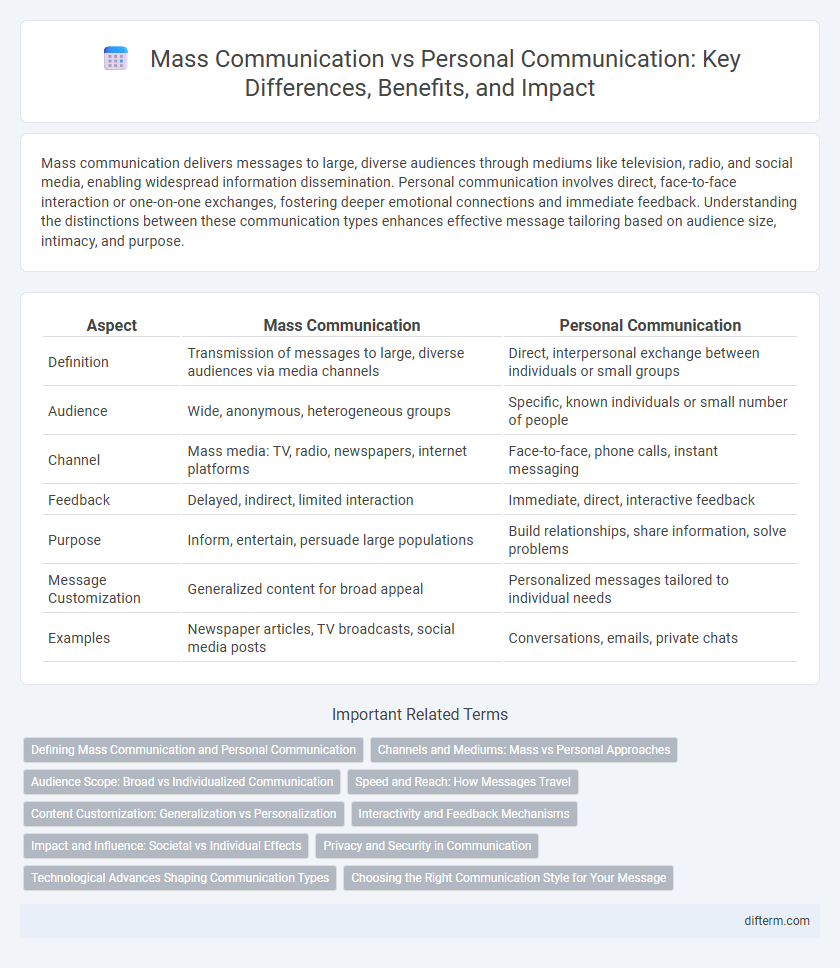Mass communication delivers messages to large, diverse audiences through mediums like television, radio, and social media, enabling widespread information dissemination. Personal communication involves direct, face-to-face interaction or one-on-one exchanges, fostering deeper emotional connections and immediate feedback. Understanding the distinctions between these communication types enhances effective message tailoring based on audience size, intimacy, and purpose.
Table of Comparison
| Aspect | Mass Communication | Personal Communication |
|---|---|---|
| Definition | Transmission of messages to large, diverse audiences via media channels | Direct, interpersonal exchange between individuals or small groups |
| Audience | Wide, anonymous, heterogeneous groups | Specific, known individuals or small number of people |
| Channel | Mass media: TV, radio, newspapers, internet platforms | Face-to-face, phone calls, instant messaging |
| Feedback | Delayed, indirect, limited interaction | Immediate, direct, interactive feedback |
| Purpose | Inform, entertain, persuade large populations | Build relationships, share information, solve problems |
| Message Customization | Generalized content for broad appeal | Personalized messages tailored to individual needs |
| Examples | Newspaper articles, TV broadcasts, social media posts | Conversations, emails, private chats |
Defining Mass Communication and Personal Communication
Mass communication involves transmitting information to large, diverse audiences through mediums like television, radio, newspapers, and digital platforms, focusing on standardized messages designed for public consumption. Personal communication refers to face-to-face or direct interactions between individuals, emphasizing tailored, interactive exchanges that foster personal relationships and immediate feedback. The distinction lies in the scale and customization of the message, with mass communication targeting broad audiences and personal communication engaging specific individuals or small groups.
Channels and Mediums: Mass vs Personal Approaches
Mass communication relies on broad channels such as television, radio, newspapers, and social media platforms to reach large audiences simultaneously, emphasizing one-to-many dissemination. Personal communication utilizes direct mediums like face-to-face conversations, phone calls, and instant messaging that enable tailored, interactive exchanges between individuals or small groups. The choice of channel or medium significantly impacts message customization, feedback immediacy, and audience engagement levels in communication processes.
Audience Scope: Broad vs Individualized Communication
Mass communication targets a broad audience through mediums like television, radio, and social media, enabling the dissemination of information to millions simultaneously. Personal communication focuses on individualized interaction, often involving direct, two-way exchanges through face-to-face conversation, phone calls, or personalized messaging. The scope in mass communication emphasizes wide reach and general content, while personal communication prioritizes tailored, context-specific messages for specific recipients.
Speed and Reach: How Messages Travel
Mass communication enables rapid dissemination of information to vast audiences through mediums such as television, radio, and social media platforms, reaching millions almost instantaneously. Personal communication, typically occurring through direct channels like phone calls, messaging apps, or face-to-face conversations, allows for tailored, immediate exchanges but with a limited audience size. The speed of message delivery in mass communication is unparalleled, while personal communication offers more depth and interaction within smaller reach.
Content Customization: Generalization vs Personalization
Mass communication delivers generalized content designed to reach a broad audience, prioritizing message consistency over individual relevance. Personal communication emphasizes content customization, tailoring messages to the recipient's preferences, context, and feedback for deeper engagement. This contrast highlights the scalability of mass media against the intimacy and specificity achievable through personalized interactions.
Interactivity and Feedback Mechanisms
Mass communication typically features one-way information flow with limited interactivity, relying on broad dissemination channels like television and radio. Personal communication enables dynamic, real-time feedback through direct exchanges such as face-to-face conversations or instant messaging. Interactive feedback mechanisms in personal communication enhance engagement and comprehension, while mass communication's feedback is often delayed or indirect, limiting immediate audience response.
Impact and Influence: Societal vs Individual Effects
Mass communication shapes societal norms and public opinion by disseminating information to large audiences, influencing cultural trends and collective behavior on a broad scale. Personal communication impacts individual emotions and relationships, fostering deeper connections and tailored understanding within smaller social contexts. The societal effects of mass communication often drive widespread change, while personal communication nurtures individual growth and interpersonal dynamics.
Privacy and Security in Communication
Mass communication often lacks robust privacy measures, exposing large audiences to potential data breaches and unauthorized surveillance, while personal communication typically employs stronger encryption protocols to protect individual exchanges. Security vulnerabilities in mass communication platforms can lead to widespread dissemination of sensitive information, whereas personal communication prioritizes confidentiality through end-to-end encryption and secure authentication methods. Ensuring privacy in mass communication requires implementing advanced cybersecurity frameworks to mitigate risks associated with data interception and unauthorized access.
Technological Advances Shaping Communication Types
Technological advances such as the internet, social media platforms, and mobile devices have significantly expanded the reach and immediacy of mass communication, enabling global information dissemination to millions simultaneously. In contrast, personal communication benefits from technologies like video calls, instant messaging, and virtual reality, which facilitate intimate and interactive exchanges despite physical distance. These innovations continuously reshape the dynamics, efficiency, and accessibility of both mass and personal communication channels.
Choosing the Right Communication Style for Your Message
Mass communication efficiently delivers messages to broad audiences through channels like television, radio, or social media, ideal for announcements or public campaigns. Personal communication involves direct, interactive exchanges, such as face-to-face conversations or phone calls, best suited for sensitive or detailed information requiring feedback. Selecting the appropriate communication style depends on the message's purpose, audience size, and desired level of engagement to ensure clarity and effectiveness.
mass communication vs personal communication Infographic

 difterm.com
difterm.com